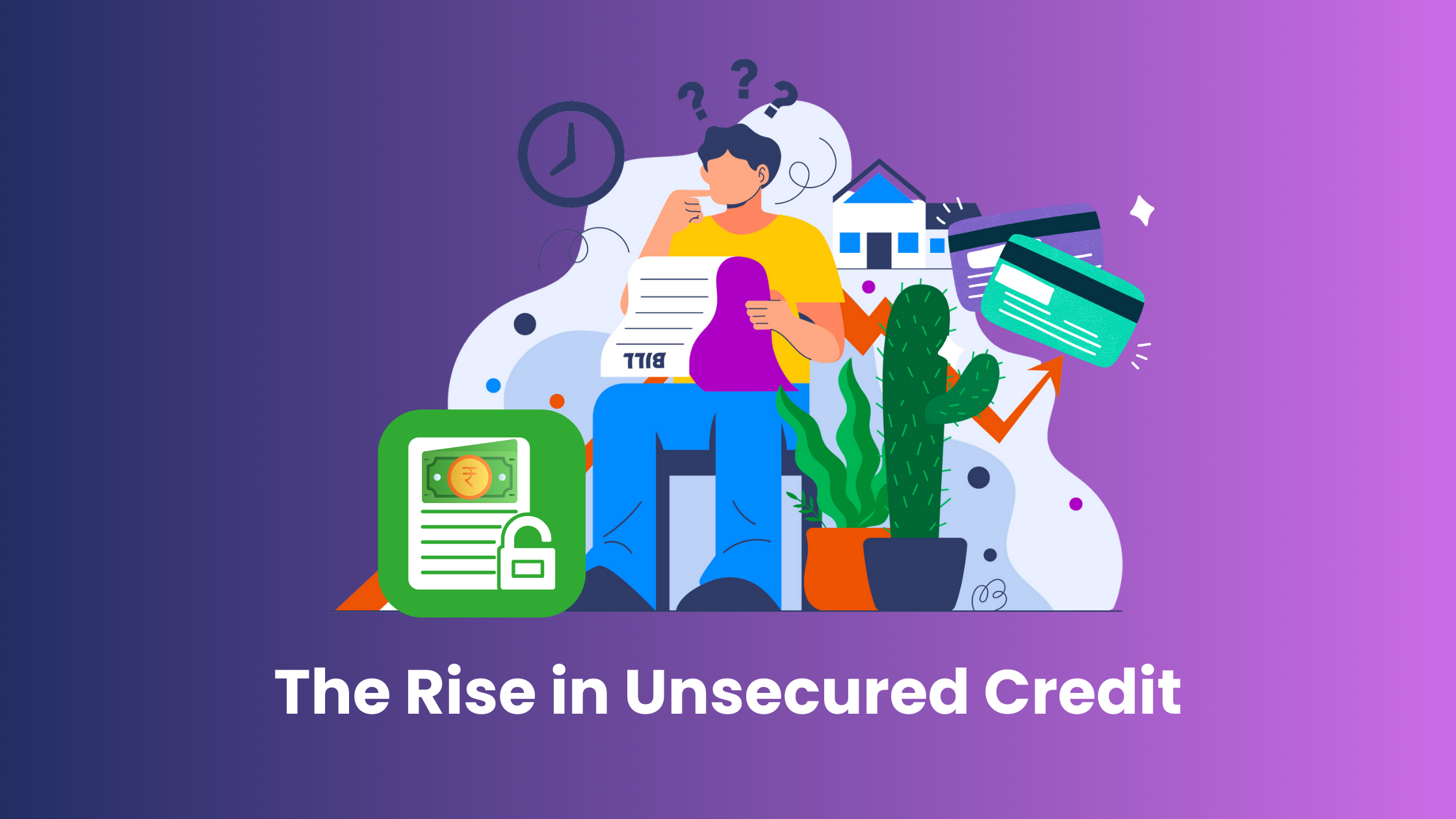Unsecured credit refers to loans that are not backed by any collateral. Common examples include credit cards and personal loans, which have become increasingly popular in India due to their convenience and accessibility. In recent years, India has witnessed significant growth in the unsecured credit market, driven by the rise of digital banking, increased consumer spending, and a growing aspirational middle class. The proliferation of fintech companies and digital lending platforms has further accelerated this trend, providing consumers with a variety of options to meet their financial needs.
However, the rapid expansion of unsecured credit has raised concerns about potential financial stability risks, prompting scrutiny from the Reserve Bank of India (RBI). To address these concerns, the RBI has implemented measures such as increasing risk weights for unsecured loans. While the increase in unsecured loans could lead to a rise in bad loans in the future, these loans can be highly profitable if undertaken with adequate underwriting.
Understanding risk weights on bank exposures
Banks have to hold a certain amount of money as a safety net, in case their assets (the things they own or are owed) lose value. The amount of money they have to hold depends on how risky their assets are.
The central bank and financial regulators use “risk weights” to determine how much capital a bank needs to hold. Assets that are considered low-risk, like cash and government bonds, have a lower risk weight. This means banks don’t need to hold as much capital for these assets.
On the other hand, riskier assets such as consumer loans, corporate loans, and derivatives have higher risk weights. Banks have to set aside more capital to cover these higher-risk assets, in case they lose value.
For example, cash and government securities might have a 0% or very low risk weight, meaning banks don’t need to hold much capital for these. But things like unsecured consumer loans, corporate loans, and derivatives could have risk weights from 20% up to 150% or more, requiring banks to hold a lot more capital to cover them.
The risk weight system helps make sure banks have enough financial cushion to withstand potential losses on their riskier assets.
Reasons for rising popularity of unsecured credit
1. Easy Accessibility: Unsecured credit products such as credit cards and personal loans are readily available, allowing consumers to access funds quickly without the need for collateral. Banks and other financial institutions often promote these products as convenient solutions for immediate financial needs.
2. Minimal Documentation: Compared to secured loans, unsecured credit requires lesser documentation and has a faster approval process. This simplicity appeals to individuals who might find traditional loans cumbersome or inaccessible.
3. Instant Gratification: The ability to purchase goods and services immediately, even without sufficient cash on hand, is a powerful motivator for consumers. Credit cards, in particular, offer rewards and incentives that further entice people to spend.
Role of digital lending platforms
Digital lending platforms have played a significant role in the growth of unsecured credit. These platforms leverage technology to streamline the loan application process, making it easier for consumers to obtain credit. They use advanced algorithms to assess creditworthiness, often providing instant approvals and disbursements. As a result, these platforms have expanded access to credit for many individuals, including those who might be underserved by traditional banks.
The dark side of unsecured credit: Understanding the risks
1) High Interest Rates: Loans without collateral often carry higher interest charges than those backed by assets. This can lead to significant
financial burdens for borrowers, especially if they carry balances on their credit cards or fail to repay personal loans promptly.
2) Debt Traps: The ease of obtaining unsecured credit can lead to excessive borrowing, resulting in a cycle of debt that is difficult to escape.
Borrowers may find themselves struggling to make minimum payments, accruing more debt, and ultimately facing financial distress.
3) Impact on Financial Stability: The rapid growth of unsecured credit poses potential risks to the broader financial system. If a significant portion of borrowers default on their loans, it could lead to increased non-performing assets for banks and financial institutions, threatening economic stability.
4) Increase in Credit Card Fraud and Data Breaches: As unsecured credit becomes more prevalent, incidents of credit card fraud and identity theft have also increased. Cybercriminals exploit vulnerabilities in digital platforms to gain unauthorized access to personal information and financial data, resulting in significant losses for both consumers and financial institutions.
Measures taken by RBI to manage unsecured credit
In response to these concerns, the RBI has taken steps to increase risk weights on unsecured loans. By requiring banks to hold more capital against such loans, the RBI aims to mitigate potential risks associated with defaults and encourage more prudent lending practices.
These measures may lead to stricter lending criteria, making it more difficult for consumers to obtain unsecured credit. While this could slow down the growth of unsecured credit, it may also encourage responsible lending and borrowing practices, ultimately contributing to greater financial stability.
Further, the RBI is keeping a close watch on data to decide if additional actions are needed. It emphasizes that the boards and top management of regulated entities should ensure their risk limits align with their risk appetite framework. Additionally, the gap between credit and deposit growth rates suggests that bank boards should reconsider their business strategies to maintain a wise balance between assets and liabilities.
The RBI may consider additional regulatory measures, such as setting caps on interest rates for unsecured loans or implementing more stringent credit assessment processes. These steps could help further reduce risks associated with unsecured credit.
Recommended Read: The rise of Fintech SROs: Balancing innovation and regulation in India’s financial landscape
Striking the right financial balance
Unsecured credit plays a crucial role in facilitating financial inclusion, providing individuals with access to funds for emergencies, education, and entrepreneurship. It enables consumers to manage cash flow and meet short-term financial needs, contributing to economic growth. However, financial literacy is essential in managing unsecured credit effectively. Educating consumers about the risks and benefits of unsecured loans can empower them to make informed decisions and avoid falling into debt traps.
To ensure responsible borrowing, consumers should:
- Evaluate their financial health and limit borrowing to amounts they can confidently reimburse.
- Understand the terms and conditions of loans, including interest rates and fees.
- Use credit for necessary expenses rather than impulsive purchases.
- Create a realistic repayment plan that aligns with their budget and financial goals.
- Regularly monitor their credit report to ensure accuracy and protect against identity theft.
Final thoughts
The growth of unsecured credit in India may have both advantages and higher risk. While it increases financial accessibility, the risks need to be catered to. The concerns expressed by The Reserve Bank of India emphasize the need for a cautious approach, balancing the benefits and potential threats to financial stability.
As India navigates this complex landscape, a focus on responsible lending and borrowing, along with robust regulatory measures, will be crucial for the future of unsecured lending. By understanding the dynamics of unsecured credit and adopting responsible financial practices, consumers can leverage its benefits while mitigating associated risks.
FAQs:
1. What is unsecured credit, and why has it become so popular in India?
Unsecured credit refers to loans that do not require collateral, such as credit cards and personal loans. It has gained popularity in India due to its easy accessibility, minimal documentation requirements, and the ability to obtain funds quickly. The rise of digital banking and fintech companies has also contributed to the growth of unsecured credit by streamlining the loan application process and expanding access to credit.
2. What are the potential risks associated with the growth of unsecured credit?
The rapid expansion of unsecured credit poses several risks, including high-interest rates, the potential for debt traps, and increased credit card fraud. Borrowers may face significant financial burdens if they cannot repay loans on time, leading to a cycle of debt. Additionally, the increase in unsecured loans could impact financial stability if a large number of borrowers default, resulting in higher non-performing assets for banks and financial institutions.
3. How is the Reserve Bank of India (RBI) addressing the concerns related to unsecured credit?
To mitigate the risks associated with unsecured credit, the RBI has increased risk weights on unsecured loans. This requires banks to hold more capital against these loans, encouraging more prudent lending practices. The RBI also monitors data to assess if additional regulatory measures are needed, such as setting caps on interest rates or implementing stricter credit assessment processes.
4. What role do digital lending platforms play in the growth of unsecured credit?
Digital lending platforms have significantly contributed to the growth of unsecured credit by leveraging technology to simplify the loan application process. These platforms use advanced algorithms to assess creditworthiness, often providing instant approvals and disbursements. As a result, they have expanded access to credit for individuals who may be underserved by traditional banks, making it easier for consumers to obtain unsecured loans.
5. What measures can consumers take to manage unsecured credit responsibly?
To manage unsecured credit effectively, consumers should evaluate their financial health and borrow only what they can repay. Understanding loan terms and conditions, including interest rates and fees, is crucial. Consumers should use credit for necessary expenses, create a realistic repayment plan, and monitor their credit reports regularly to protect against identity theft and ensure accuracy.
6. How does the rise of unsecured credit impact financial stability in India?
The rise of unsecured credit can impact financial stability by increasing the risk of defaults and non-performing assets for banks. If a significant number of borrowers fail to repay their loans, it could threaten economic stability. Therefore, balancing the benefits of unsecured credit with potential risks is essential to ensure long-term financial stability in India.






